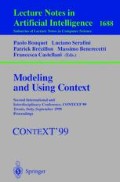Abstract
This paper presents a definition of context for the interpretation of word-structure that is based on the formal relation of asymmetry. We provide evidence that morpho-conceptual complexity is optimally tractable in terms of local asymmetrical relations in formal context. We present the main features of a morpho-conceptual parser implementing our proposal. We show, on the basis of the comparison with existing morphological parsers, that the accuracy of the analysis increases when the operations of the parser are oriented by the recognition of local asymmetries in formal contexts. We predict that the inclusion of modules scanning local asymmetries in information processing systems will increase their precision.
Access this chapter
Tax calculation will be finalised at checkout
Purchases are for personal use only
Preview
Unable to display preview. Download preview PDF.
References
Antworth, E., PC-KIMMO: A Tow Level Processor for Morphological Analysis. Dallas, TX: Summer Institute of Linguistics (1990)
Arampatzis, A.T., Tsoris, T., Koster, C.H.A.: IRENA: Information Retrieval Engine Based on Natural Language Analysis. RIAO 97 Proceedings, McGill University (1997)
Basili, R., Vindigni, M., M. T. Pazienza.: Corpus-driven unsupervised learning of verb subcategorization frames. In Proc. Of the Italian Association for Artifical Intelligence, AI*IA 97, Rome (1997)
Berwick, R.: Principle-Based Parsing. Dordrecht: Kluwer Academic Publishers (1991)
Benerecetti, M., Cimatti, A., Giunchiglia, F., Serafini, L.: Context-Based Formal Specification of Multi-Agent Systems. In: proceedings of the Third International Workshop on Agent Theories, Architectures, and Languages (ATAL-96), ECAI-96, Budapest (1996)
Chomsky, N.: Lectures on Government and Binding. Foris Publications (1981)
Chomsky, N.: The Minimalist Program. Cambridge: The MIT Press (1995)
Chomsky, N.: Minimalist Inquiries. Ms. MIT (1998)
Church, K.: Stochastic Parts Program and NP Parser for Unrestricted Text, Proceedings of the Second Association of Computational Linguistics Conference on Applied Natural Language Processing (1988)
Cimatti, A., Serafini, L.: Multi-Agent Reasoning with Belief Contexts III: Towards Mechanization. In: Brezillon, P., Abu-Hakim, S. (eds.): Proceedings (1995) of the IJCAI-95 Workshop on “Modelling Context in Knowledge Representation and Reasoning” (1995) 35–45
Derose, S. J.: Grammatical Category Disambiguation by Statistical Optimization, Computational Linguistics, Vol. 14.1 (1988)
Di Sciullo, A.M.: Modularity and Xo/XP Asymmetries. Linguistic Analysis Vol. 26 (1996)
Di Sciullo, A.M.: Prefixed verbs and Adjunct Identification. In A.M. Di Sciullo (ed) Projections and Interface Conditions. Oxford University Press. (1997a)
Di Sciullo, A.M.: Argument Structure Parsing. In: Ralli, A., Grigoriadou, M., Philokyprou, G., Christodoulakis, D., Galiotou, E. (eds.) Papers in Natural Language Processing. (1997b) 55–77
Di Sciullo, A.M.: Features and Asymmetrical Relations in Morphological Objects. GLOW Newsletter (1998)
Di Sciullo, A.M.: The Local Asymmetry Connection. Penn/MIT Workshop on The Lexicon. MIT (1999)
Di Sciullo, A.M.: Conceptual Knowledge and Interpretation. In: ICCS/JICSS, Chukyo, Japan (In press)
Di Sciullo, A.M.: Asymmetries, Morphological Configurations and Paradigms. In: Acta Linguistica Hungarica, Hungarian Academy of Sciences and Kluwer Academic Publishers (to appear)
Di Sciullo, A.M., Tenny, C.: Modification, Event Structure and the Word/Phrase Asymmetry. NELS 18, (1998)
Di Sciullo, A.M., Williams, E.: On the Definition of Word. Cambridge: The MIT Press (1987)
Epstein, S.: The Derivation of Syntactic Relations. Ms. Harvard University (1995)
Fong, S.: The Computational Implementation of Principle-Based Parsing. In Berwick, R. and al. (eds.) Principle-Based Parsing. Dordrecht: Kluwer Academic Publishers (1991) 65–83
Kartunnen, L.: KIMMO: A General Morphological Processor in Texas Linguistic Forum 22 (1983) 163–186
Kayne, R.: Connectedness and Binary Branching. Dordrecht: Foris (1984)
Kayne, R.: The Antisymmetry of Syntax. Cambridge, MA.: MIT Press (1994)
Lieber, R.: Deconstructing Morphology. Chicago University Press. (1992)
Marken, C.G.: Parsing the LOB Corpus. Association of Computational Linguistics Annual Meeting (1990)
Pohlmann, R., Kraaij, W.: The Effect of Syntactic Phrase Indexing on Retrieval Performance for Dutch Texts. RIAO 97 Proceedings. McGill University, Montreal (1997)
Porter, M.F.: An Algorithm for suffix Stripping in Program 14.3 (1980)
Reinhart, T.: Anaphora and Semantic Interpretation. Croom Helm, London (1983)
Robert, F., Vijayashankar, K.: C-command and Grammatical Primitives. GLOW Newsletter (1995)
Reuland, E.: Deriving C-command in Binding. NELS 18 (1998)
Savoy, J.: Stemming of French Words Based on Grammatical Categories in Journal of the American Society for Information Sciences 44.1 (1993)
Uszkoreit, H.: Unification in Linguistics. Class Lectures, 2nd European Summer School in Language, Logic and Information, Leuven (1990)
Author information
Authors and Affiliations
Editor information
Editors and Affiliations
Rights and permissions
Copyright information
© 1999 Springer-Verlag Berlin Heidelberg
About this paper
Cite this paper
Di Sciullo, AM. (1999). Formal Context and Morphological Analysis. In: Bouquet, P., Benerecetti, M., Serafini, L., Brézillon, P., Castellani, F. (eds) Modeling and Using Context. CONTEXT 1999. Lecture Notes in Computer Science(), vol 1688. Springer, Berlin, Heidelberg. https://doi.org/10.1007/3-540-48315-2_9
Download citation
DOI: https://doi.org/10.1007/3-540-48315-2_9
Published:
Publisher Name: Springer, Berlin, Heidelberg
Print ISBN: 978-3-540-66432-1
Online ISBN: 978-3-540-48315-1
eBook Packages: Springer Book Archive

